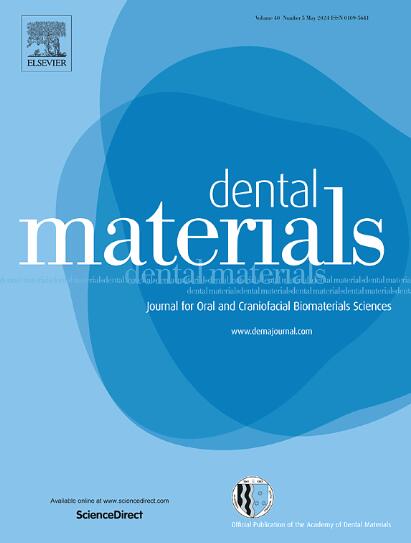Influence of surface treatment before glazing on wear and flexural strength of translucent zirconia
IF 4.6
1区 医学
Q1 DENTISTRY, ORAL SURGERY & MEDICINE
引用次数: 0
Abstract
Objectives
To determine whether the surface treatment of translucent zirconia prior to glazing affects wear and flexural strength.
Methods
Translucent zirconia disks were either left as-sintered, polished, or sandblasted. Half of the specimens within these three groups were glazed. Human enamel and dentin substrates were prepared as control. The wear volume and depth, as well as surface roughness parameters, were obtained after chewing simulation (n = 8 per group). Biaxial flexural strength of zirconia specimens was measured and fractures were analyzed. Statistics was performed with multifactorial ANOVAs (α = 0.05).
Results
The overall wear volume was significantly higher on glazed surfaces (0.020 ± 0.007 mm3) compared to non-glazed zirconia (0.001 ± 0.001 mm3; p < 0.001). No significant difference in wear volume was found among different surface treatments (p = 0.368). Nevertheless, wear volume significantly increased when rough antagonists were used for zirconia and tooth substrates (both p < 0.001). The lowest wear volume was measured on polished zirconia (< 0.001 ± < 0.001 mm3) and highest on dentin (2.327 ± 1.686 mm3). The flexural strength was significantly higher for polished zirconia surfaces (652 ± 135 MPa) than for all other groups (p < 0.001).
Significance
Lowest wear and highest flexural strength of a translucent zirconia restoration can be expected when the surface is polished. When applying glaze, the prior surface treatment does not affect wear. Applied to clinical situations, perfect surface polishing after occlusion adjustments is recommended to prevent increased wear of the antagonist.
上光前表面处理对半透明氧化锆磨损和抗弯强度的影响。
目的:确定半透明氧化锆在上光前的表面处理是否会影响磨损和抗弯强度。方法:采用烧结、抛光或喷砂法制备半透明氧化锆圆盘。这三组中有一半的标本是上釉的。制备人牙釉质和牙本质基质作为对照。模拟咀嚼后得到磨损体积、深度和表面粗糙度参数(n = 8 /组)。测定了氧化锆试件的双轴抗折强度,并对断裂进行了分析。统计学采用多因素方差分析(α = 0.05)。结果:釉面氧化锆的整体磨损量(0.020 ± 0.007 mm3)明显高于未釉面氧化锆(0.001 ± 0.001 mm3;P < 3),牙本质最高(2.327 ± 1.686 mm3)。抛光氧化锆表面的抗弯强度(652 ± 135 MPa)明显高于其他所有组(p )。意义:当表面抛光时,可以预期半透明氧化锆修复体的最低磨损和最高抗弯强度。在上釉时,先前的表面处理不影响磨损。应用于临床,建议在咬合调整后进行完美的表面抛光,以防止拮抗剂的磨损增加。
本文章由计算机程序翻译,如有差异,请以英文原文为准。
求助全文
约1分钟内获得全文
求助全文
来源期刊

Dental Materials
工程技术-材料科学:生物材料
CiteScore
9.80
自引率
10.00%
发文量
290
审稿时长
67 days
期刊介绍:
Dental Materials publishes original research, review articles, and short communications.
Academy of Dental Materials members click here to register for free access to Dental Materials online.
The principal aim of Dental Materials is to promote rapid communication of scientific information between academia, industry, and the dental practitioner. Original Manuscripts on clinical and laboratory research of basic and applied character which focus on the properties or performance of dental materials or the reaction of host tissues to materials are given priority publication. Other acceptable topics include application technology in clinical dentistry and dental laboratory technology.
Comprehensive reviews and editorial commentaries on pertinent subjects will be considered.
 求助内容:
求助内容: 应助结果提醒方式:
应助结果提醒方式:


